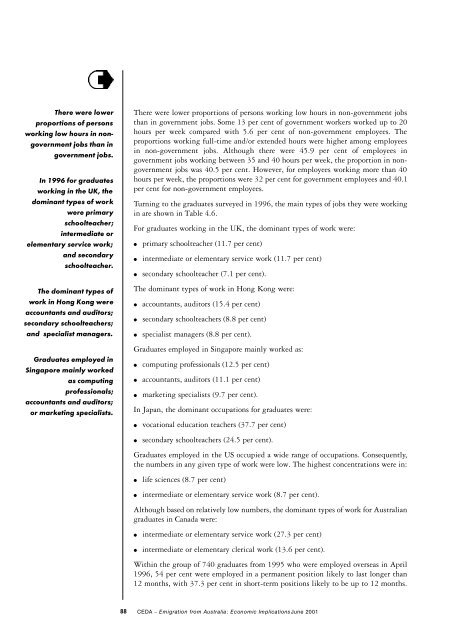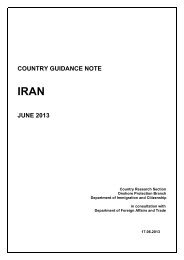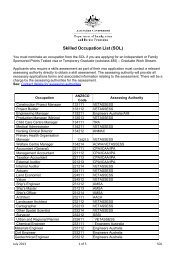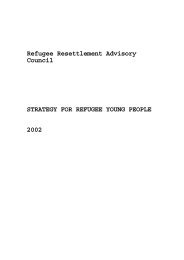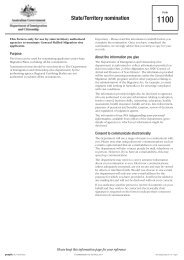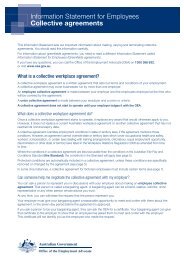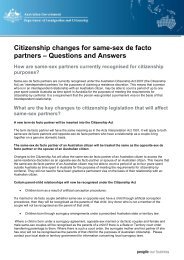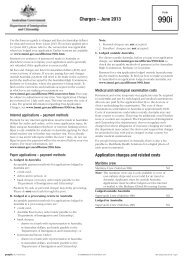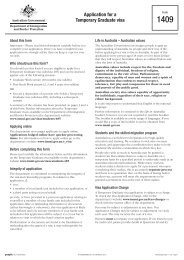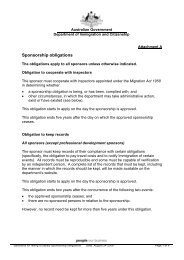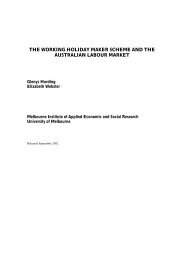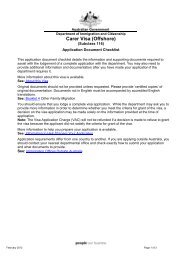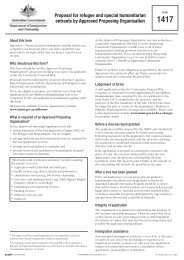part three - Department of Immigration & Citizenship
part three - Department of Immigration & Citizenship
part three - Department of Immigration & Citizenship
Create successful ePaper yourself
Turn your PDF publications into a flip-book with our unique Google optimized e-Paper software.
There were lower<br />
proportions <strong>of</strong> persons<br />
working low hours in nongovernment<br />
jobs than in<br />
government jobs.<br />
In 1996 for graduates<br />
working in the UK, the<br />
dominant types <strong>of</strong> work<br />
were primary<br />
schoolteacher;<br />
intermediate or<br />
elementary service work;<br />
and secondary<br />
schoolteacher.<br />
The dominant types <strong>of</strong><br />
work in Hong Kong were<br />
accountants and auditors;<br />
secondary schoolteachers;<br />
and specialist managers.<br />
Graduates employed in<br />
Singapore mainly worked<br />
as computing<br />
pr<strong>of</strong>essionals;<br />
accountants and auditors;<br />
or marketing specialists.<br />
There were lower proportions <strong>of</strong> persons working low hours in non-government jobs<br />
than in government jobs. Some 13 per cent <strong>of</strong> government workers worked up to 20<br />
hours per week compared with 5.6 per cent <strong>of</strong> non-government employees. The<br />
proportions working full-time and/or extended hours were higher among employees<br />
in non-government jobs. Although there were 45.9 per cent <strong>of</strong> employees in<br />
government jobs working between 35 and 40 hours per week, the proportion in nongovernment<br />
jobs was 40.5 per cent. However, for employees working more than 40<br />
hours per week, the proportions were 32 per cent for government employees and 40.1<br />
per cent for non-government employees.<br />
Turning to the graduates surveyed in 1996, the main types <strong>of</strong> jobs they were working<br />
in are shown in Table 4.6.<br />
For graduates working in the UK, the dominant types <strong>of</strong> work were:<br />
●<br />
●<br />
●<br />
primary schoolteacher (11.7 per cent)<br />
intermediate or elementary service work (11.7 per cent)<br />
secondary schoolteacher (7.1 per cent).<br />
The dominant types <strong>of</strong> work in Hong Kong were:<br />
●<br />
●<br />
●<br />
accountants, auditors (15.4 per cent)<br />
secondary schoolteachers (8.8 per cent)<br />
specialist managers (8.8 per cent).<br />
Graduates employed in Singapore mainly worked as:<br />
●<br />
●<br />
●<br />
computing pr<strong>of</strong>essionals (12.5 per cent)<br />
accountants, auditors (11.1 per cent)<br />
marketing specialists (9.7 per cent).<br />
In Japan, the dominant occupations for graduates were:<br />
●<br />
vocational education teachers (37.7 per cent)<br />
●<br />
secondary schoolteachers (24.5 per cent).<br />
Graduates employed in the US occupied a wide range <strong>of</strong> occupations. Consequently,<br />
the numbers in any given type <strong>of</strong> work were low. The highest concentrations were in:<br />
●<br />
●<br />
life sciences (8.7 per cent)<br />
intermediate or elementary service work (8.7 per cent).<br />
Although based on relatively low numbers, the dominant types <strong>of</strong> work for Australian<br />
graduates in Canada were:<br />
●<br />
●<br />
intermediate or elementary service work (27.3 per cent)<br />
intermediate or elementary clerical work (13.6 per cent).<br />
Within the group <strong>of</strong> 740 graduates from 1995 who were employed overseas in April<br />
1996, 54 per cent were employed in a permanent position likely to last longer than<br />
12 months, with 37.3 per cent in short-term positions likely to be up to 12 months.<br />
88 C E DA – Emigration from Australia: Economic ImplicationsJune 2001


